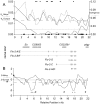Selective sweep in the Flotillin-2 region of European Drosophila melanogaster
- PMID: 23437190
- PMCID: PMC3578937
- DOI: 10.1371/journal.pone.0056629
Selective sweep in the Flotillin-2 region of European Drosophila melanogaster
Abstract
Localizing genes that are subject to recent positive selection is a major goal of evolutionary biology. In the model organism Drosophila melanogaster many attempts have been made in recent years to identify such genes by conducting so-called genome scans of selection. These analyses consisted in typing a large number of genetic markers along the genomes of a sample of individuals and then identifying those loci that harbor patterns of genetic variation, which are compatible with the ones generated by a selective sweep. In this study we conduct an in-depth analysis of a genomic region located on the X chromosome of D. melanogaster that was identified as a potential target of recent positive selection by a previous genome scan of selection. To this end we re-sequenced 20 kilobases around the Flotillin-2 gene (Flo-2) and conducted a detailed analysis of the allele frequencies and linkage disequilibria observed in this new dataset. The results of this analysis reveal eight genetic novelties that are specific to temperate populations of D. melanogaster and that may have arisen during the expansion of the species outside its ancestral sub-Saharan habitat since about 16,000 years ago.
Conflict of interest statement
Figures


References
-
- Maynard Smith J, Haigh J (1974) The hitch-hiking effect of a favourable gene. Genet Res 23: 23–35. - PubMed
-
- Stephan W, Wiehe THE, Lenz MW (1992) The effect of strongly selected substitutions on neutral polymorphism: Analytical results based on diffusion theory. Theoretical Population Biology 41: 237–254.
Publication types
MeSH terms
Substances
LinkOut - more resources
Full Text Sources
Other Literature Sources
Molecular Biology Databases

